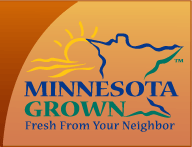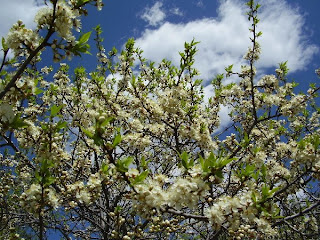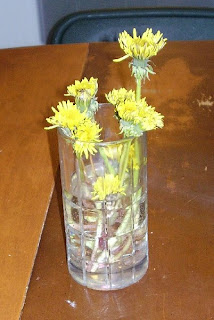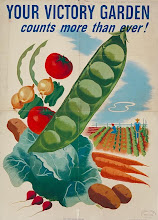We've been growing this garden at work for three years now, and I've got to tell you -- I'm a convert. I'm not using a bison hoe or an antler rake, but we are doing no till and no
Monday, May 26, 2008
Three Sisters
We've been growing this garden at work for three years now, and I've got to tell you -- I'm a convert. I'm not using a bison hoe or an antler rake, but we are doing no till and no
Trust your food
Yes, I am a pack-rat. Anyone who knows me will tell you this. I am also a hoarder. That means at any given time, I have about two months worth of food in my house. I claim that I like to buy in bulk because it saves money, but the real reason is that I like to have lots of food on hand. You never can be too prepared, right?
I would like to be more self-sufficient. I don't trust big
companies. I think that if big companies have a choice between making lots of money selling an unhealthy product, and making less money selling a healthy product, they'll go for the first option. One of those big companies I distrust is Monsanto. Distrust is too soft a word for what I feel toward Monsanto. What they are doing to the world's food supply is very, very scary.
So, in my own very little way, I am trying to be more self-sufficient and less reliant on big food companies. We have a large garden and preserve a lot of what we grow. I save vegetable seed from year to year. We're members of a local CSA. I buy our natural beef, pork and chicken from local farmers. I shop at the local co-op and have joined an organic food buying club. I buy milk straight from the dairy. Our food is local, healthy and tasty. I'm not trying to be preachy, but I am pleased about most of the choices we've made. That's not to say we've given up on supermarket food altogether -- heavens, no. But the money we spend there has gotten less and less over the years.


It's amazingly easy to eat local these days. There are numerous guides available for many areas of the country. Lots of local co-ops have information that will help you get started. Or just do a google search for CSAs in your town. It seems every week there is a news story about product recalls, animal mistreatment, genetic food engineering and chemical toxicity. Knowing where your food comes from and what goes into it is a great liberating experience.
Here's links to several local food guides for Minnesota:
MN Dept. of Agriculture: http://www.mda.state.mn.us/food/minnesotagrown/
Slow Food Minnesota: http://www.slowfoodmn.org/local.html
Land Stewardship Project: http://www.landstewardshipproject.org/foodfarm-main.html
Upper MN River Valley: http://www.prideoftheprairie.org/
Southeast MN: http://southeastmnfoodnetwork.com/smfn/
MN Farmers Market Association: http://www.mfma.org/
Sunday, May 18, 2008
True sign of spring

Some think it's the first robin, others think it's the first daffodil blooming. For me, the first real signs of spring are plum blossoms. Robins and daffodils give a false sense of security in Minnesota, where snow storms are common in April and not unheard of in May. When the plum trees start to blossom, you know you can finally put away your hat and mittens. For five months, at least.
For those of you still living in suburbia, or urbia for that matter, wild plums are something very special. Prunus Americanus, wild plums grow along lakeshores and creek beds in almost every state in the US. Their blossoms are heaven scent, their fruit truly divine. These aren't the plums you find in the supermarket; in fact, the only way to taste a wild plum is to actually go out and find one in the wild. In Minnesota, the best times for looking are in August, but ripening times vary with weather and location.
 One day last summer I was working at another state park on a very sunny, hot August afternoon. I was carrying some heavy equipment, had just walked about three miles through rough terrain, and was still a half mile from the shop where coolness and water bottles were waiting. I stopped briefly for a rest next to a couple of rough, bedraggled looking trees, feeling mightily bedraggled myself. Parched and sweating, I look around and a small flash of pink catches my eye. A closer look, and I see more small dots of pink scattered through the branches. No! Yes! Plums! I gently pull one from the tree, slowly sink my teeth into the skin, and close my eyes in pure bliss as I taste the sweet juicy fruit.
One day last summer I was working at another state park on a very sunny, hot August afternoon. I was carrying some heavy equipment, had just walked about three miles through rough terrain, and was still a half mile from the shop where coolness and water bottles were waiting. I stopped briefly for a rest next to a couple of rough, bedraggled looking trees, feeling mightily bedraggled myself. Parched and sweating, I look around and a small flash of pink catches my eye. A closer look, and I see more small dots of pink scattered through the branches. No! Yes! Plums! I gently pull one from the tree, slowly sink my teeth into the skin, and close my eyes in pure bliss as I taste the sweet juicy fruit.Ten minutes and about thirty plums later I walk on, happy and grateful for nature's snackbar.
I tell you, if you have never tasted wild plums at the peak of ripeness, you are truly missing out. Today is a gorgeous day - go out right now and take a walk, or go for a drive along a rural road. Find a dirt road with a few bends or hills in it, which may indicate a winding creek or stream. Look on a south-facing slope for a bunch of scraggly trees bearing tons of off-white blossoms. Stake out the location, and make a point to come back in early August. You won't be disappointed.
Saturday, May 17, 2008
Good vs. Evil
Other people define weeds in other ways. Actually, every state maintains a listing of official weeds. In rural areas, counties have 'weed inspectors' that go around and make sure people don't have lots of weeds in their fields. I guess if you have a lot of weeds in your field, then your neighbor gets nervous about weed seeds blowing onto his field. If the weed inspector tells you to control your weeds, and you don't, you get in big trouble.
It's spring. My garden is starting to grow -- little rutabaga cloverettes, asparagas spears, potato sprouts and pea shoots all poking through the soil. But way ahead of all of these delights is the dandelion. The dandelions in my garden have already flowered and are beginning to seed. Thousands upon thousands of them in my yard, some sneaking out into the alfalfa field around our homestead.

The line between good and evil is blurred when it comes to dandelions. Are they good or evil? Thankfully they're not officially listed as a state noxious weed in Minnesota, otherwise I'd be in big trouble.
Pesticide companies have convinced millions of people that dandelions are evil, and that we need to spend lots of money on chemicals to remove them. Frankly I think the chemicals used to kill dandelions are far more evil than the dandelions are. But try convincing a homeowners' association of that.
In my garden they take up valuable vegetable space and no matter how many you pull out, ten times that amount will sprout back up the following week. Yet they are beautiful, turning a empty green sky of lawn into a starlit expanse of yellow. If I had more time and motivation, I might even try picking the young greens for salad, or collecting the flowers for wine.
 Perhaps the turning point in the argument for me is what happens at about 4 o-clock in the afternoon on a school day in the spring. My seven-year-old gets dropped off the bus, walks into our yard and kneels down on the grass. He then comes into the house gripping a handful of yellow flowers picked for his mom.
Perhaps the turning point in the argument for me is what happens at about 4 o-clock in the afternoon on a school day in the spring. My seven-year-old gets dropped off the bus, walks into our yard and kneels down on the grass. He then comes into the house gripping a handful of yellow flowers picked for his mom.Dandelions are most definitely good.
P.S. Minnesota's official noxious weed list can be seen here: http://plants.usda.gov/java/noxious?rptType=State&statefips=27
Thursday, May 8, 2008
Nuggets and Bricks
 Meet Babou, the French Voyageur who traveled in this area during the fur trade era of the early 19th century. Babou paid a visit to the state park last weekend and brought a sizeable collection of trade goods from that era with him. Visitor turn-out was low, probably because this was the first nice Saturday we'd had this spring, and people were busy catching up with spring to-dos in their own yards.
Meet Babou, the French Voyageur who traveled in this area during the fur trade era of the early 19th century. Babou paid a visit to the state park last weekend and brought a sizeable collection of trade goods from that era with him. Visitor turn-out was low, probably because this was the first nice Saturday we'd had this spring, and people were busy catching up with spring to-dos in their own yards.I've been to many naturalist programs at parks, and I am always overwhelmed by the amount of cool stuff I want to learn. Over time I've learned that I won't remember all of it; in fact, I'll hardly remember any of it afterward, unless I focus on just one or two really cool nuggets of information. If all works well, these nuggets will get wedged into my head and become permanent memories.
One of the nuggets I'm taking away with me from last weekend is about tea. I don't drink coffee, but I do like tea. Not fruity tea, not flowery tea, not herbal tea, but just plain jane English Breakfast tea. The kind I used to drink with breakfast in the mornings at my guest house while studying abroad in Edinburgh. The kind that goes so well with butter-baked shortbread during a rare quiet moment sitting at the kitchen table in the late afternoon. Yum.
On Saturday I saw my first tea brick. Tea bricks are literally bricks made out of steamed and pressed tea leaves. If you want to make tea from them, you just take a knife and scrape some of it off into your cup. Tea bricks became so widely used and accepted that they served as currency during the 19th and 20th century in Tibet, Mongolia, Siberia, and Northern China. They have fancy designs on them and are scored on the back for easy breaking to make change. People would even put these bricks in frames and hang them on their walls as a symbol of their wealth.

I picked up the tea brick and smelled it, thinking I was going to smell the lovely aroma of tea. Wrong. What I smelled was much less pleasant. This made sense after I read on Wikipedia that "Some tea bricks were also mixed with binding agents such as flour, blood, or manure in order to even better preserve their form such that they could withstand physical use as currency." Not so yum.
So these people loved tea so much that it began to represent something more than just tea, something people used for money, something they coveted and kept and showed off to their neighbors. In the process, they managed to change the very nature of the thing they started with. I'm sure many folks didn't notice that their hot cup of tea was now a hot cup of tea and manure, but I'm sure there were some.
We live three miles from Big Stone Lake. I'm told that forty years ago there were many large stretches of open shoreline. Cabins were few and far between. Deer and fox could wander from the grasslands down to the lakeside without trouble, and otter and beaver built homes along the shore. Nowadays I'd hazard a guess that over 70% of the shoreline has houses or cabins or mown grass. Fox are scarce, beaver even scarcer and otter almost non-existent.
I'm not saying that I want Big Stone County to stay the same. I want people to repopulate rural areas, to realize how great it is to live away from the city, how great it is to reconnect with the landscape. I just want to be sure that in the process of revitalization, we all don't end up drinking hot cups of manure tea.
Saturday, May 3, 2008
Let them sleep

The snow is gone, finally. Trees are budding out, birds are busy nesting, and dandelions are pushing through the ground in my garden.
We have 14 acres, 8 of which are in alfalfa. In this picture my two youngest are running through the alfalfa stubble, stretching their winter legs. Beyond our alfalfa is another field, then another. The trees in the distance mark several abandoned farmsteads. Then farther, the valley of the source of the Minnesota River, Big Stone Lake.
The first time I saw Big Stone Lake, it reminded me a lot of the Scottish Lochs. Long (26 miles long) and narrow (1 mile at its widest). Scottish Lochs, however, can reach several hundred feet deep. Big Stone Lake reaches about 16 feet at its deepest.
The lake and this county are named for the many granite boulders found in the soil. These boulders came with the glaciers, left behind when the ice melted and drained down River Warren. They've rested here for centuries upon centuries, nestled into the soil, sleeping quiet and heavy.
These boulders were the bane of the early pioneer, chipping plowblades and breaking backs. Nowadays it's relatively easy for a farmer to move these sleeping giants. Big City landscapers will pay farmers to haul them away, to be placed as large hulking decor in a suburban front yard. Uprooted, displaced, their sleep disrupted.
It's hard to find a field of original stone out here now. We've lost much of what has made us special.


